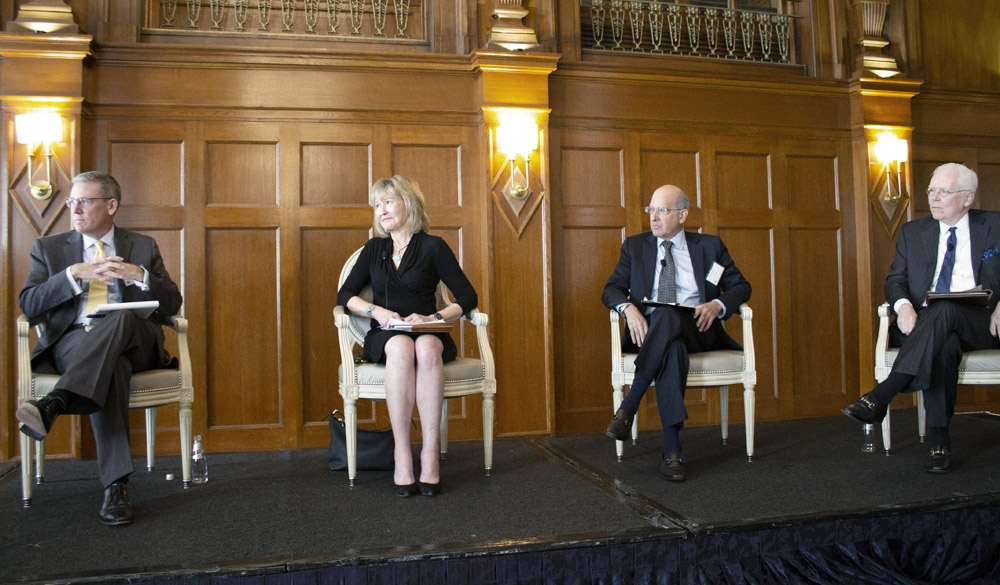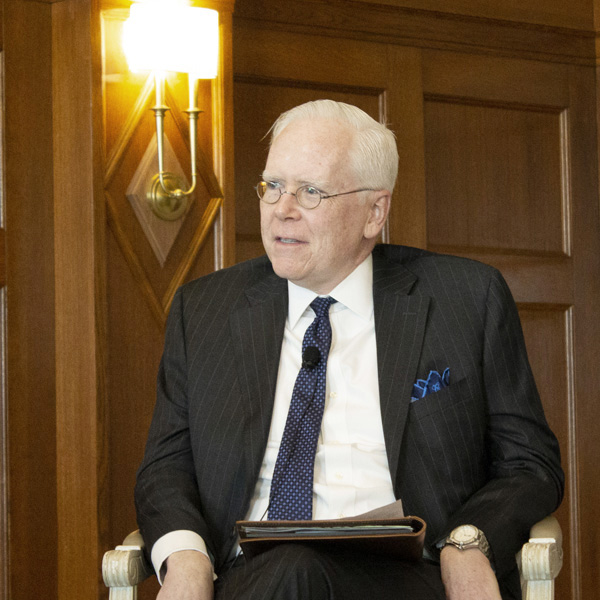WASHINGTON — Electric transmission providers are pinning their hopes for long-sought-after changes on FERC’s Advance Notice of Proposed Rulemaking, a sweeping inquiry into the commission’s rules on transmission planning, cost allocation and generator interconnection (RM21-17).
Attendees of transmission trade association WIRES’ Fall Conference on Thursday peppered FERC Commissioner Allison Clements at the Willard InterContinental Washington hotel, just blocks from the White House, with questions about the ongoing proceeding, which drew hundreds of comments last month. (See FERC Tx Inquiry: Consensus on Need for Change, Discord over Solutions.)
The organization also drew four former FERC commissioners to the event to give advice for commission staff working on the proceeding, as well as recount their experiences working on the commission’s landmark transmission orders.
There seemed to be an expectation among panelists and attendees alike that whatever comes out of the ANOPR will be significant.
“You understand the pace of regulatory change,” Clements told attendees in a keynote speech opening the conference. “You understand that this is our bite at the apple. And that’s why I think we do need to go big.” She cited concerns about recent extreme weather events and preventing severe climate change. “It’s really an important moment to think about big ideas, creative ideas, and we’re looking for those in the record. … This is the chance to pivot the ship.”
But what exactly that action is and what form it will take is still guesswork. Many speakers cautioned that it will likely take at least a year before the commission reaches any final rule, as it asked hundreds of questions and received so many comments. It’s also possible that the commission issues several orders, each taking on specific issues, rather than a massive, holistic one, they said.
They also noted that while the ANOPR’s issuance was unanimous among the four sitting commissioners, Republicans James Danly and Mark Christie issued separate concurrences expressing their individual concerns; Clements and Chair Richard Glick issued a joint concurrence. (See FERC Goes Back to the Drawing Board on Tx Planning, Cost Allocation.)

Joseph T. Kelliher, former FERC chair under President George W. Bush, said the proceeding looks more like a Notice of Inquiry at this point than the form of a preliminary proposal that an ANOPR usually takes. “The ANOPR asks [some] extremely high-level, 50,000-foot[-high] questions,” he said. “There are some proposals in there, but because of the concurrences, it’s hard to say that those are commission proposals. … There is much more division among the commissioners than was true for [Order] 890, Order 1000 and Order 2003.”
Kelliher said “the worst possible outcome would be to slap together a NOPR that’s rushed and then issue a final rule that’s also [rushed] under the logic of, ‘Well, we’ll fix it on rehearing.’ That’s an expression at FERC that I hate. … I would hope that they’re not driven by an arbitrary deadline because it’s so much better to spend the time and sweat the details to get out a really good proposed rule, and perhaps the final rule could be issued relatively quickly.”
He and the other former commissioners also advised that FERC focus any proposed rulemakings on specific, solvable problems.
“Keep it focused on concrete things that are squarely within the commission’s jurisdiction and that you have a very good grasp on,” said Tony Clark, a senior adviser for Wilkinson Barker Knauer. “To the degree that orders start to push the bounds of that and get into controversial or nebulous areas, you’re increasing the chances of dissenting votes.”
 Joseph T. Kelliher, FedArb | © RTO Insider LLC
Joseph T. Kelliher, FedArb | © RTO Insider LLC“The more focused the rulemaking is, the easier it is,” said Suedeen Kelly, a partner with Jenner & Block and co-chair of its energy practice. “This is not a focused rulemaking; however, the less focused it is, the more important it is to go through the rulemaking process — and the harder it is. … This one is going to be a big burden” for staff.
Marc Spitzer, partner with Steptoe & Johnson, counseled being mindful of changed circumstances and unintended consequences. He recalled that Order 1000, issued in 2011, was partially in response to the 2008 elections, in which Democrats won control over both houses of Congress and the White House.
The status quo in 2008, in which transmission was built by vertically integrated utilities within their own jurisdictions in reaction to new generation projects, “worked pretty well,” he said. But Spitzer expected Democrats to pass cap-and-trade legislation, “which would radically change the transmission grid [and] fuel mix. … So that was the problem we were trying to solve with Order 1000. And of course, circumstances change.” The Waxman-Markey Bill, which would have set up such a cap-and-trade system, failed, and many new technologies, notably distributed energy resources, became more prominent as FERC worked on the rule, Spitzer said.
Spitzer, a Republican, also urged the commission to work toward consensus. He noted that he voted for Order 1000 with the majority, breaking with his Republican colleague Phil Moeller, who issued a partial dissent. Spitzer had offered amendments that the majority agreed to work into the order. A former Arizona state legislator and regulator, he said “if you’re going to offer an amendment, you have to vote for the bill. Would you rather get 50% of something, or 100% of nothing?”
Addressing the audience, Kelly said, “If I were your lawyer, what I would say is that you should not only use the comments as a way to effectively advocate your position, but you should go talk to staff, because they’re going to have a lot of comments to read and sift through and create a record around, and it’s going to be hard to get all those into one collective mind, but even harder to decide what are the most important things.”
Back in the Room
Many attendees could be overheard during coffee breaks and meals expressing wonderment over being in the same room again and their fatigue with virtual meetings. For many, it was their first time being at a gathering since the onset of the COVID-19 pandemic early last year, which led to event cancellations, restricted travel and social distancing.
All attendees were required to present either proof of vaccination or a negative COVID test with the past 72 hours. They were also required to wear masks when walking in the hotel’s hallways, and all but a few continued to wear them as they listened to speakers and panelists. But during the post-event lunch, there was a sense of optimism about future in-person events.
“There is no substitute for personal interaction,” Spitzer told moderator Larry Gasteiger, executive director for WIRES. “We’re in an unprecedented time of polarization” in government. “I don’t know if the drivers of the polarization will abate, but the tone and tenor of the discussion is better when you look people in the eye.”
This optimism also led to a bit more humor among panelists than at your average energy conference, especially among the former commissioners.
Kelliher joked that early in his tenure at FERC, Kelly told him the commission needed to work on “the queue,” meaning backlogged generator interconnection queues. He did not know what she was talking about, joking that perhaps she was referencing Q, a mysterious, mischievous alien character in “Star Trek.”
Speaking about the challenges of siting interstate transmission, Spitzer recalled meeting in 2007 with the superintendent of the Gettysburg Battlefield, which lay in the Department of Energy’s recently announced Mid-Atlantic Area National Corridor. The superintendent warned that if a transmission line were built through the battlefield, it would be worse than the carnage from the battle itself.



